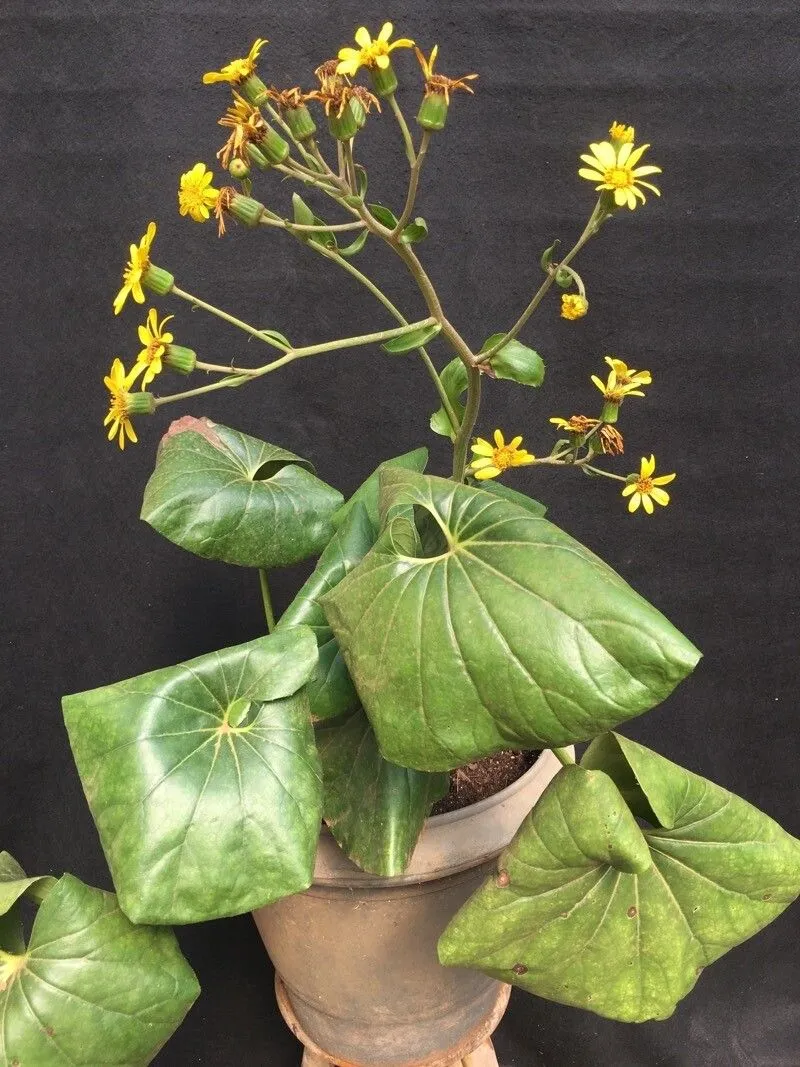
Author: (L.) Kitam.
Bibliography: Acta Phytotax. Geobot. 8: 268 (1939)
Year: 1939
Status: accepted
Rank: species
Genus: Farfugium
Vegetable: False
Observations: S. China to Temp. E. Asia
The Leopardplant, scientifically known as Farfugium japonicum, is a captivating member of the Asteraceae family. This ornamental perennial is cherished for its lush, broad, and glossy green leaves that create an eye-catching ground cover in gardens and landscapes. The name “Leopardplant” aptly describes the distinctive yellow spots that often embellish its foliage, resembling the spots of a leopard.
Native to regions extending from southern China to temperate areas of East Asia, including Japan, Korea, and Taiwan, the Leopardplant thrives in shaded and semi-shaded environments where it can benefit from moist, well-drained soil. While the plant primarily flourishes in these climates, its adaptability also makes it suitable for cultivation in various other temperate zones.
Farfugium japonicum boasts a unique flowering period that contrasts with its lush green backdrop. Typically, in late autumn to early winter, the Leopardplant produces clusters of small, daisy-like, yellow flowers held on tall, slender stalks that rise above the foliage. These bright blooms offer an unexpected splash of color during a time when many other plants have ceased blooming, thus adding ornamental value to the garden throughout the year.
Apart from its ornamental appeal, the Leopardplant is relatively easy to maintain, making it a popular choice among gardeners. It requires minimal care, needing only occasional watering and protection from direct, harsh sunlight to prevent leaf scorching. Regular application of organic mulch can help retain soil moisture and provide the necessary nutrients for optimal growth.
Given its attractive foliage, vibrant flowers, and low maintenance needs, the Leopardplant is a versatile addition to shaded garden areas, borders, and even container gardens. Its striking appearance and adaptability have cemented its place as a beloved plant among horticultural enthusiasts in both residential and public garden settings.
As a member of the Asteraceae family, Farfugium japonicum provides not only aesthetic beauty but also contributes to the biodiversity of its native and cultivated environments. Whether used as a focal point in garden design or as part of a lush, green understory, the Leopardplant continues to fascinate and delight plant lovers around the world.
Deu: japanische leopardenpflanze, leopardenpflanze
Eng: leopardplant
Swe: tigertass
En: Leopardplant, Farfugium, Leopard Plant, Ligularia
Zh: Da wu feng cao, 大吴风草
Cs: Popelivka podbělovitá
Fi: Japaninnauhio
De: Leopardenpflanze, Japanische Leopardenpflanze
Ja: Tsuwabuki
Ko: 털머위
Sv: Tigertass
Zh-tw: 山菊
Zh-hant: 大吳風草
© copyright of the Board of Trustees of the Royal Botanic Gardens, Kew.
© copyright of the Board of Trustees of the Royal Botanic Gardens, Kew.
© copyright of the Board of Trustees of the Royal Botanic Gardens, Kew.
Taken Nov 17, 2019 by miracle xavier (cc-by-sa)
Taken Dec 30, 2019 by López Ana (cc-by-sa)
Taken Dec 12, 2021 by Taco The Chihuahua (cc-by-sa)
Taken Jun 5, 2021 by Ron spivey (cc-by-sa)
Taken May 17, 2021 by 文博 瀨尾 (cc-by-sa)
Taken Nov 26, 2019 by francois tissot (cc-by-sa)
Taken Nov 16, 2021 by ??? 囧 (cc-by-sa)
Taken Sep 1, 2022 by Linda Faber (cc-by-sa)
Taken Nov 19, 2019 by Perlado José Luis (cc-by-sa)
Taken Dec 18, 2019 by Daniel García Escrivá (cc-by-sa)
Taken Feb 13, 2022 by Francois Mansour (cc-by-sa)
Taken Oct 11, 2019 by Pereira Jorge (cc-by-sa)
Taken Mar 5, 2019 by Tela Botanica − La Spada Arturo (cc-by-sa)
Taken Jan 13, 2020 by Kremer Rita (cc-by-sa)
Taken Mar 7, 2012 by Tela Botanica − Yoan MARTIN (cc-by-sa)
Taken Jul 13, 2022 by Thierry Salem (cc-by-sa)
Taken Mar 7, 2012 by Tela Botanica − Yoan MARTIN (cc-by-sa)
Taken Nov 29, 2022 by elisabeth hoffmann (cc-by-sa)
Taken Mar 7, 2012 by Tela Botanica − Yoan MARTIN (cc-by-sa)
Taken May 7, 2022 by Lorenzi Harri (cc-by-sa)
Taken Jul 7, 2018 by Ness Martin (cc-by-sa)
Taken Nov 24, 2020 by dotras martin (cc-by-sa)
Taken May 24, 2020 by Drew Tekani (cc-by-sa)
Taken Jan 13, 2020 by Kremer Rita (cc-by-sa)
Taken Jun 7, 2020 by Paulo Antunes (cc-by-sa)
Taken Jan 1, 2022 by huy HO (cc-by-sa)
Taken Nov 26, 2021 by Marzanna Bug (cc-by-sa)
Taken Jun 16, 2021 by Joan Francesc (cc-by-sa)
Taken Nov 4, 2021 by alesim (cc-by-sa)
Taken Dec 25, 2021 by Will Clark (cc-by-sa)
Family: Myrtaceae Author: (F.Muell.) K.D.Hill & L.A.S.Johnson Bibliography: Telopea 6: 402 (1995) Year: 1995 Status:…
Family: Rubiaceae Author: Pierre ex A.Froehner Bibliography: Notizbl. Bot. Gart. Berlin-Dahlem 1: 237 (1897) Year:…
Family: Sapindaceae Author: Koidz. Bibliography: J. Coll. Sci. Imp. Univ. Tokyo 32(1): 38 (1911) Year:…
Family: Asteraceae Author: A.Gray Bibliography: Pacif. Railr. Rep.: 107 (1857) Year: 1857 Status: accepted Rank:…
Family: Fabaceae Author: Medik. Bibliography: Vorles. Churpfälz. Phys.-Ökon. Ges. 2: 398 (1787) Year: 1787 Status:…
Family: Aspleniaceae Author: (Cav.) Alston Bibliography: Bull. Misc. Inform. Kew 1932: 309 (1932) Year: 1932…